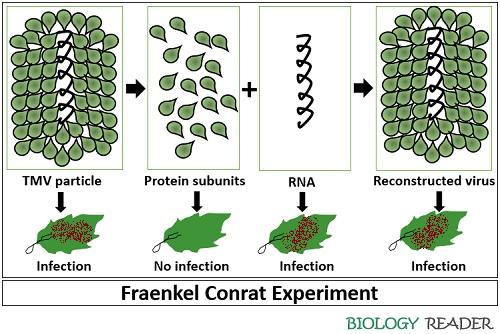Fraenkel Conrat experiment was based on the evidence that RNA also carry genetic information. This was the very first experiment that was introduced to prove that RNA is also a genetic material with the help of TMV. Tobacco Mosaic Virus is composed of 6% of RNA (not DNA) and protein.
Frankel-Conrat and co-workers determined that the reconstitution of infective virus particles may occur after the association of protein subunits and RNA. Before this experiment, there were many experimental proofs that proved DNA being a genetic material. So, it was difficult for Fraenkel to prove RNA also carries a hereditary material.
Content: Fraenkel Conrat Experiment
Experiment
In the year 1957, Fraenkel Conrat and Singer reconstituted viruses after mixing mutant strain’s protein with the other strain’s RNA. As a result, the new virus particles produced by the infected host plant that has the protein type produced by the RNA parent.
Fraenkel Conrat was famous for his viral research, where he studied that in some viruses (like TMV or HRV), RNA is the controlling factor for viral reproduction or reconstitution.
Experimental Organism
Fraenkel-Conrat (1957) conducted experiments on TMV to demonstrate that a few viruses contain RNA. TMV or Tobacco Mosaic Virus is a small plant virus that causes infection in solanaceous plants that appear as in the mosaic pattern.
Tobacco mosaic virus comprises a single coiled RNA encapsulated in a cylindrical protein coat. Different strains of TMV are characterized by differences in the chemical composition of their protein coats.
Procedure
Step-1: Fraenkel Conrat first developed techniques to isolate proteins and RNA of TMV by using the appropriate chemical treatments. After isolation, it was observed that the protein alone did not cause infection in the tobacco leaves. In contrast, the separated RNA molecule was sufficient enough to cause mosaic in the tobacco leaves.

Step-2: Then Fraenkel Conrat reversed the process by mixing the protein and RNA under appropriate conditions. After mixing the protein subunits or capsomers of TMV with the RNA molecule, he observed the reconstitution or formation of complete infective TMV particles.
Step-3: In the third experiment, Fraenkel-Conrat and Singer took two different strains of TMV (type-A and type-B). Then they separated the RNAs from the protein coats. After that, both Fraenkel-Conrat and Singer mixed proteins of one strain with the RNA of the second strain to reconstitute hybrid viruses.
After rubbing the hybrid or reconstituted viruses onto live tobacco leaves, the phenotypically and genotypically identical progeny viruses were produced similar to the parental type from which the RNA had been isolated.
Conclusion
Therefore, by all these experiments, Fraenkel Conrat concluded that both DNA and RNA carries genetic information. By his experiments, it was proved that the genetic information of TMV is stored in the RNA and not in the protein.
However, DNA perhaps always function as genetic material, but RNA, in most cases, is non-genetic. Only in specific systems, where the DNA is absent, RNA function as hereditary material.